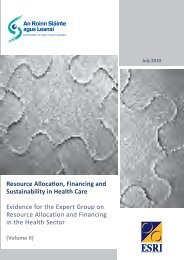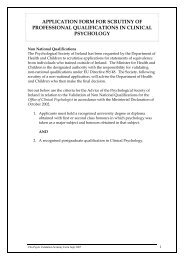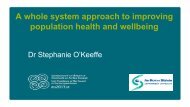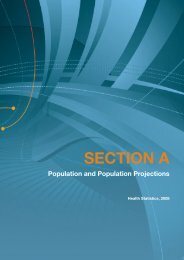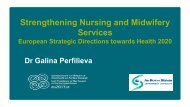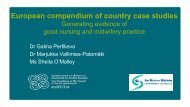Brennan Report - Department of Health and Children
Brennan Report - Department of Health and Children
Brennan Report - Department of Health and Children
You also want an ePaper? Increase the reach of your titles
YUMPU automatically turns print PDFs into web optimized ePapers that Google loves.
Chapter 2 Overview <strong>and</strong> IssuesTable 2.3: <strong>Health</strong> Expenditure by Programme 2002 4 Source: Revised Estimates for Public Services 2002.Programme Expenditure % <strong>of</strong> Total Non-Capital¤ Million Programme¤ Million1. General Hospital 3,832 48%2. Community <strong>Health</strong> Services 1,332 17%Including: GMS GP Service (¤ 738m)Drug Refund Schemes (¤ 344m)3. Community Protection/Welfare 985 12%4. Programme for the Disabled 969 12%5. Psychiatric 570 7%6. General Support 339 4%Total 8,028 5 100%Consequence 3: Primary source data on patientsPrimary source data about patients, their needs <strong>and</strong> the comparative costs <strong>and</strong> effectiveness <strong>of</strong>different treatment options are not collected <strong>and</strong> so are not available to the pr<strong>of</strong>essionals whoprescribe these treatments. For example, data collected from records on "Diagnosis RelatedGroups" <strong>and</strong> "Casemix" (see Appendix 5) are not systematically reviewed <strong>and</strong> interpreted by theclinicians from whose practices it is collected. 6 The result is that quality information onclinical work, clinical outputs <strong>and</strong> their comparative cost, agreed by clinicians, is not available toclinicians <strong>and</strong> management to evaluate the cost effectiveness <strong>of</strong> services provided. This is afundamental weakness when trying to determine the real costs <strong>of</strong> providing services <strong>and</strong>conducting teaching <strong>and</strong> research. Such information is basic in the evaluation <strong>of</strong> performance<strong>and</strong> in planning changes in the configuration <strong>of</strong> primary, secondary or tertiary medical servicesin order to improve services to patients or to control costs. Examples <strong>of</strong> the problemscreated by the absence <strong>of</strong> systematic evaluation <strong>of</strong> resource use were presented to us by theIrish Hospital Consultants Association. They highlighted the bed blockage problem existing inDublin hospitals because patients that are medically fit to be discharged have nowhere to go.They also highlighted the waste <strong>of</strong> Consultants’ time arising from the cancellation <strong>of</strong> electiveadmissions to make beds available for Accident <strong>and</strong> Emergency admissions. Until theunderlying causes <strong>of</strong> the waste <strong>of</strong> such expensive resources are tackled, it is not possible todecide whether an extra 3,000 acute hospital beds <strong>and</strong> 1,000 extra Consultants, as4Because <strong>of</strong> an accruals adjustment, the totals in this table do not directly accord with the cash allocation from the Exchequer asshown in Table 2.1.5Rounding affects the total.6We underst<strong>and</strong> that the entire national Casemix dataset (both activity <strong>and</strong> costs), is shared with all hospitals, <strong>and</strong> their staff (bothclinical <strong>and</strong> management) who participate in the system. Data for both the hospital itself, <strong>and</strong> all other hospitals in the programme,can be accessed <strong>and</strong> viewed locally.27



